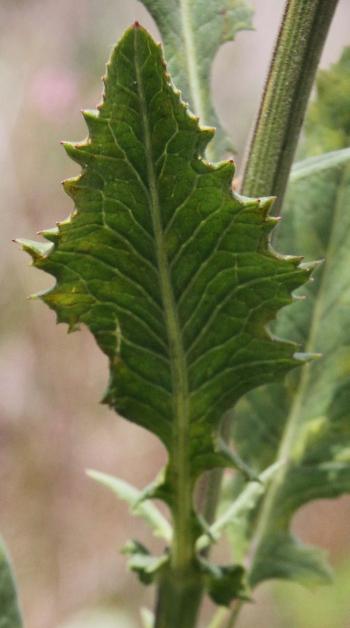Senecio gerrardii
Senecio gerrardii Harv.
Family: Asteraceae
Common names: foma, leshwabe, moroborobo o monyenyane (Sesotho)
Introduction
Visitors to wetland areas in Mpumalanga would be very familiar with this very characteristic species. It is particularly common in the Verlorenvlei area, near Dullstroom.

Description
Description
Tufted perennial herb, with single or multiple stems from the base, up to 2 m tall. The whole plant is very densely glandular-hairy.

Leaves larger and lyre or fiddle-shaped in the lower parts, with small auricles at the base, 110–200 × 50–130 mm; upper leaves much smaller, sessile; margins coarsely and irregularly toothed.

The inflorescence is a large, open, sparse panicle, with many heads. Heads are discoid, up to 12 mm long, with a single row of 5–7, narrow, calyculus bracts. Florets are usually dark purple, but sometimes also occur in lighter shades.

Pappus of white, plumed bristles, obvious before floret lobes open, but often hidden in the mature capitula. Achenes are cylindric, ribbed and glabrous.

Plants start flowering in midsummer (December), but mostly peak flowering in late summer and autumn (March and April).
Conservation Status
Status
Senecio gerrardii is evaluated as Least Concern (LC) in the Red List of South African plants.
Distribution and habitat
Distribution description
Senecio gerrardii occurs most commonly in Mpumalanga, Swaziland, KwaZulu-Natal and Limpopo, but is also found in the Free State and Eastern Cape. Plants are quite prolific in wetlands and marshy areas, but are also found on mountain slopes and along forest margins.

Derivation of name and historical aspects
History
Named after William Tyrer Gerrard, pioneer collector in KwaZulu-Natal and Madagascar.

Ecology
Ecology
The mass of flower heads attract a variety of insects gathering nectar and pollen. Pollination is, therefore, very effective and copious amounts of fertile seed are produced.
Uses
Use
Very little is documented on the use of Senecio gerrardii, but according to Moffett (2010), it is used by the Basotho people to seduce people; or a decoction of the roots can be drunk as an emetic for bilious attacks; or the leaves are ground and mixed with bath water to chase away evil spirits.
Growing Senecio gerrardii
Grow
Not much is known about the cultivation of Senecio gerrardii and it is not likely to become a popular garden subject. However, it has attractive foliage and can be very effectively used in moist areas and around ponds in a garden. It should grow very easily from seed sown directly into soil and kept moist. It dies back in the dry season and resprouts after rain.
References
- Hilliard, O.M. 1977. Compositae in Natal. University of Natal Press, Pietermaritzburg.
- Moffett, R. 2010. Sesotho plant and animal names and plants used by the Basotho. Sun Press, Bloemfontein.
- Raimondo, D. et al. 2009. Red list of South African plants. Strelitzia 25. SANBI (South African National Biodiversity Institute), Pretoria.
Credits
Marinda Koekemoer
National Herbarium, Pretoria
July 2017
Plant Attributes:
Plant Type: Perennial
SA Distribution: Eastern Cape, Free State, Gauteng, KwaZulu-Natal, Limpopo, Mpumalanga
Soil type: Clay, Loam
Flowering season: Late Summer
PH: Neutral
Flower colour: Purple, Mauve/Lilac
Aspect: Full Sun
Gardening skill: Easy
Special Features:
Horticultural zones









Rate this article
Article well written and informative
Rate this plant
Is this an interesting plant?
Login to add your Comment
Back to topNot registered yet? Click here to register.